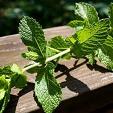Cooking with herbs and spices can provide a flavor of adventure to any meal. Many herbs seem to give off their best flavours when mixed into foods that originate from other cultures. To give you a recap, below are the more popular list of what herbs and spices are suited to your diet:
~ The HERBS ~
Basil - this herb has a sweet, minty, mild peppery flavor and is very suitable for chicken and fish recipes. Very popular in Italian cooking as this is a perfect addition to many light salads and a basic ingredient in pesto. Packed with key nutrients such as vitamins A, B1, B3, C, calcium, iron, magnesium, phosphorus, potassium, zinc, manganese, panthothenic acid, and folate.
Bay leaves, laurel or sweet bay - these are the dried leaves of the evergreen laurel tree. This herb has a woody, mildly astringent flavour with a slight taste of mint and provides wonderful flavours to meats, fish, poultry, stews, and vegetables. Packed with key nutrients such as calcium, iron, magnesium, phosphorus, potassium, zinc, manganese, vitamins A, B2, B3, B6, C, and E, folate and fibre. Tip: Bay leaves should be removed before serving.
Chervil or Coriander - this herb has an aromatic lacy leaves that brings sweetness and anise-like flavor to a food. Similar to parsley, chevril can be used to garnish and flavor almost any dish and combines well with other herbs. Packed with key nutrients such as calcium, iron, magnesium, phosphorus,
potassium, zinc, manganese, vitamins A, B1, B2, B3, B6, C, and E, folate and
fibre. Tip : Chevril should be added at the last minute as while cooking if added right at the start, limits to savor the flavor.
Dill - this herb has a slightly bitter taste and unusual but quite fascinating fragrance. This can be used to flavor salads, fish and lamb. This is also an essential ingredients for Greek salads and serves as a natural preservative when making pickles. Key nutrients include calcium, phosphorus, sodium, potassium, iron, vitamins A, B1, B2 and B3.
Chives - this herb has a slender, bright green, rushlike leaves and reveals a mild onion-like flavor. You can consider this as a mild substitute for onions when thinking of herbs. Perfect to garnish for salads, soups, broths, stews, omelets, scrambled eggs, and cooked vegetables. With key nutrients such as calcium, iron, magnesium, phosphorus,
potassium, zinc, manganese, a significant amount of vitamin C, A, B, B2, B3, B6 and E, folate and fiber.
Tip : To have a final and decorative touch, put chives blossoms to your salads.
Marjoram - this comes from the perennial herb of the mint family. It has a pleasing fragrant aroma and has flavor similar to thyme and for that they are typically used in combination or to replace the other. Marjorams are good to be added to almost every dish usually with egg dishes, lamb, poultry, sausages, soups, stews, and vegetables. Key nutrients include calcium, copper, iron, phosphorus, potassium, magnesium, vitamins A, B6, C and K, folate and dietary fiber.
Tip : Marjoram's flavor is lost very quickly while cooking so add marjoram at the last minute or immediately before serving.
Mint - specifically refers to the aromatic perennial plant of the genus Mentha - peppermint and spearmint. This herbs can be used in soups, fish and meat sauces. In England, lamb without meat sauce would be unthinkable so this is a must-have on their table. Spearmint is also the preferred mint for lamb and for serving an iced tea. Peppermint key nutrients includes phosphorus, zinc, calcium, iron, magnesium, potassium, copper, manganese, vitamins A, B2, B3, C, folate and dietary fiber.
Rosemary - this herb comes from the evergreen shrub of the mint family. It gives as strong, aromatic, and slightly bitter taste to dishes. This can be good for soups, on broiled steaks, or with other meat dishes, sauces and vegetables. Key nutrients include calcium, iron, potassium, manganese, magnesium, c opper vitamins A, B6, C , folate and dietary fiber.
Parsley - this herb belongs to the Umbelliferae family which include among others carrot, celery, fennel and dill. Fresh and dried leaves are often added to fish and fish sauces, meats, sauces, soups, and vegetables. Lacy springs of parsley are regularly served on restaurant meal and this should not be taken aside as this is fully loaded with nutrients such as protein, vitamins B1, B2, B3 and B6, pantothenic acid, phosphorus and zinc; a very good source of vitamins A, C, K, calcium, iron, magnesium, potassium, copper, manganese, folate and dietary fiber.
Oregano - likewise a member of the mint family and also the name given to more than 40 species of perennial plants which dried leaves reveal a particular flavor to food. Oregano herb produced in cooler climates is not as potent as those originating from warmer climates such as in southern Italy. So this is why it is being used extensively in Italian cooking and can be added to cheese dishes, chili beans, fish, gravies, meats, sauces, sausage, salads and soups. Key nutrients are calcium, iron, magnesium, potassium, copper, manganese, vitamins A, B6,C, E (alpha tocopherol), and K, folate and dietary fiber.
Sage - comes from the mint family as well. Sage leaves are often dried and available in whole, rubbed, or ground form and can also be found in some mixed spice combinations. Commonly used for baked fish, meats and meat stuffing, sausages and sauces. Nutrients include calcium, iron, magnesium, copper, manganese, vitamins A, B3, B6, C, E, and K, folate and dietary fiber.












No comments:
Post a Comment
Thank your for your feedback!